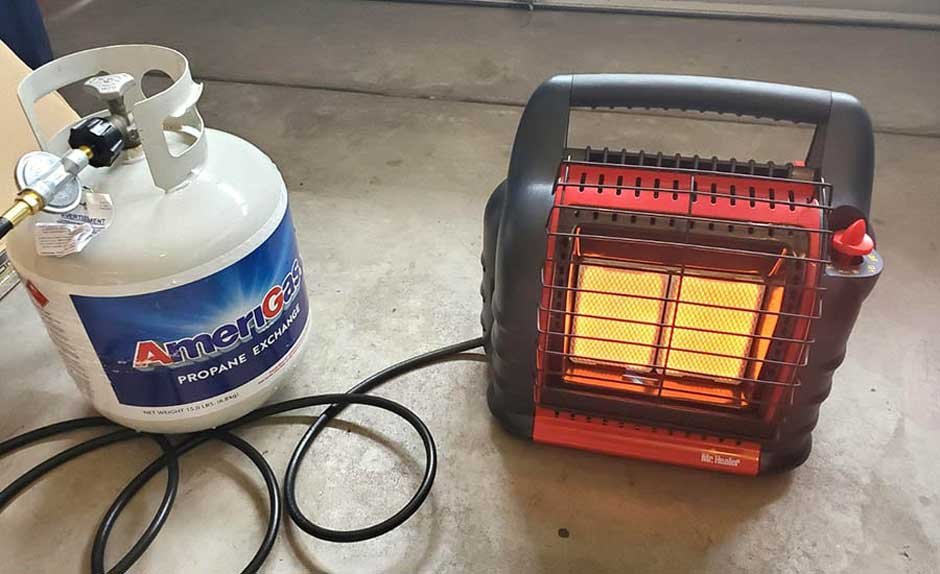Propane heaters are popular and efficient for homeowners seeking reliable, cost-effective heating solutions. However, it’s crucial to understand the ventilation requirements of these devices to ensure safe operation in your home.
In this blog post, we’ll explain the importance of proper propane heater ventilation, discuss potential dangers such as carbon monoxide poisoning, and guide you through calculating how much ventilation is needed for optimal safety. You can also get in touch with the most reliable HVAC professionals in Fort Mohave, AZ for your HVAC needs and to answer any questions you may have on propane heater ventilation.
Table of Contents
How Does Ventilation for Propane Heaters Work?
- Propane heaters can produce carbon monoxide, a dangerous gas that is colorless and odorless. Proper ventilation is crucial to prevent its accumulation indoors and protect against potential health risks or fatalities.
- A general recommendation for adequate ventilation is at least 1 square inch of free outdoor air opening per every 1,000 BTUs/hour of the propane heater. However, other factors such as room size, ceiling height, and combustion efficiency must also be taken into consideration when determining the required airflow volume in cubic feet per minute (CFM).
- It’s important to ensure that all openings are not blocked and allow fresh air to circulate throughout the room where the propane heater operates. Consult a licensed HVAC professional if you’re unsure how much ventilation your specific device requires or need help with installation or usage guidelines.
- Consider installing carbon monoxide detectors in key areas of your home as an additional safety precaution when using fuel-burning appliances like propane heaters.
Understanding The Importance Of Propane Heater Ventilation
Proper ventilation for propane heaters is crucial to prevent the danger of carbon monoxide poisoning, which can lead to serious health implications or even death.
Danger Of Carbon Monoxide Poisoning
One of the primary dangers associated with using a propane heater is the risk of carbon monoxide (CO) poisoning. Carbon monoxide is a colorless, odorless, and tasteless gas that can be deadly if too much is inhaled.
As propane heaters burn fuel to produce heat, they also generate small amounts of CO as a byproduct.
For example, imagine using an unvented propane heater in your garage during a cold winter day. While staying warm while working on projects or fixing cars may seem like a cozy solution, this confined space could become a silent hazard due to inadequate ventilation leading to elevated CO levels.
Recommended Ventilation Requirements
Proper ventilation is essential when using propane heaters, as inadequate ventilation can result in dangerous levels of carbon monoxide accumulating indoors. To ensure safety and optimal performance, it’s recommended to provide at least 1 square inch of free outdoor air opening per 1,000 BTUs/hour of the propane heater.
For example, if you have a 30,000 BTU/hour propane heater, you must provide at least 30 square inches of free outdoor air opening (e.g., an open window or door). It’s also important to ensure that the openings are not blocked and that fresh air can circulate throughout the room.
If you’re unsure how much ventilation your propane heater requires, consult the manufacturer’s instructions or a licensed HVAC professional for guidance.
How To Calculate Required Ventilation For Propane Heaters
To determine the required ventilation for your propane heater, you need to consider several factors, such as the BTU output of the unit, room size, ceiling height, and more.
But don’t worry, we’ll walk you through the formula step-by-step so that you can ensure your home remains safe while still enjoying a warm atmosphere.
Factors Affecting Ventilation Needs
Several factors can affect how much ventilation you need for your propane heater. One of the most important is the size and type of room where the heater will be used.
Another factor to consider is the BTU output of your propane heater. Higher BTU heaters produce more heat and emit more combustion byproducts, so they typically require greater ventilation than lower-output models.
Overall, ensuring that your propane heater has adequate ventilation is essential to prevent carbon monoxide poisoning or other safety hazards is essential.
Formula For Determining Ventilation Requirements
To determine the required ventilation for your propane heater, you need to consider several factors, such as the size of the room, ceiling height, and combustion efficiency of the heating unit.
The formula is simple: airflow volume (in cubic feet per minute) = BTU/hr rating ÷ 1000 × air exchange rate. The recommended air exchange rate is 4-6 times per hour for residential spaces and up to 10 times per hour for commercial or industrial settings.
For instance, if you have a 30,000 BTU propane heater in a room measuring 300 sq ft with an 8-ft ceiling height and an air exchange rate of six times per hour, your required airflow volume would be approximately 90 CFM (cubic feet per minute).
Importance Of Proper Ventilation For Propane Heater Safety
In conclusion, understanding the importance of proper ventilation when using a propane heater is crucial for your safety and well-being. Carbon monoxide poisoning can occur if there isn’t enough air circulation to remove combustion fumes from the indoor environment.
To determine how much ventilation you need for your propane heater, consider factors such as room size, ceiling height, and the BTU rating of your heating unit.
Follow the recommended guidelines for venting a propane garage heater or other indoor heaters, and consider installing carbon monoxide detectors in key areas of your home.
